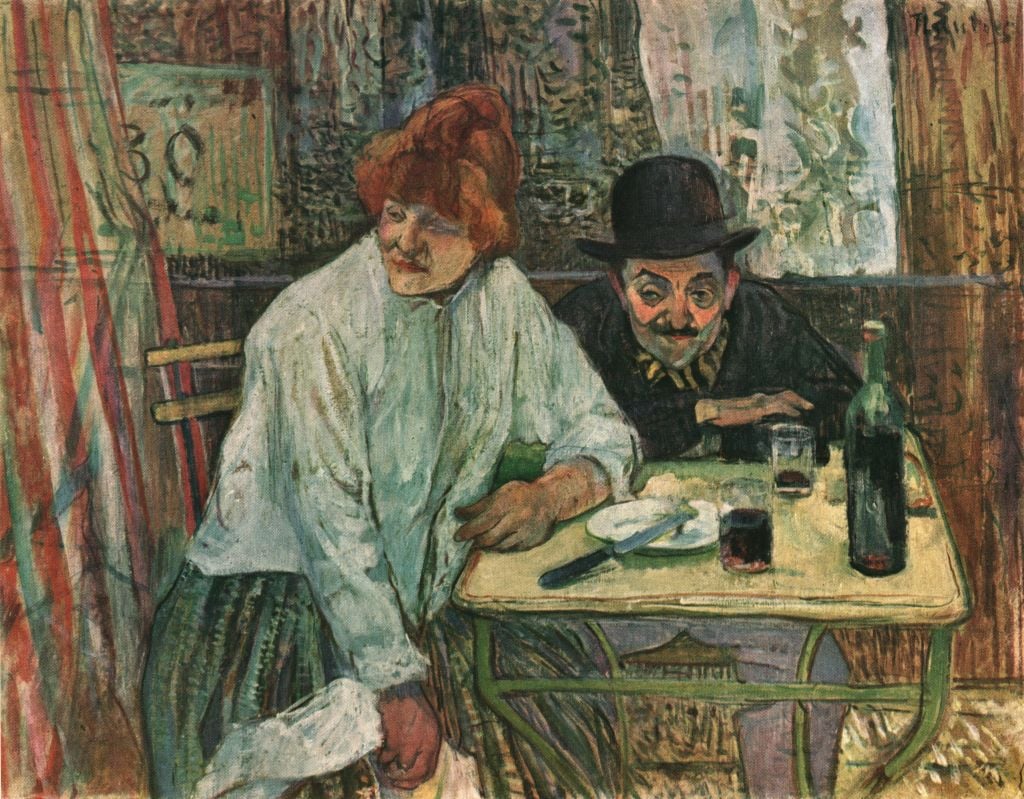
Viewing Henri de Toulouse-Lautrec’s shadowy scenes of louche Parisian cafes and nightclubs, you get the sense of a man pursuing a pleasure-filled existence. But to truly understand his sybaritic-leaning lifestyle, it is necessary to peruse The Art of Cuisine, an exhilarating cookbook that his longtime friend, the art dealer Maurice Joyant, published in a limited edition soon after the death of the artist in 1901, at the age 36.
The volume compiles recipes that Toulouse-Lautrec and Joyant developed or collected together, and reveals that the artist was a once-in-a-generation gourmand. His “studio, in addition to being a workplace, was also a bar so well-stocked that he could offer” visitors “an infinite variety of cocktails,” the scholars Philippe Huisman and M. G. Dortu write in an introduction to a 1966 reprint. These drinks, they add, were “essential,” in the artist’s view, “for the proper contemplation of a painting.”
The cover of the 1966 edition of Henri de Toulouse-Lautrec and Maurice Joyant’s The Art of Cuisine. Photo courtesy of Holt Rinehart Winston.
Indeed, making art and preparing feasts seem to have been equally important to the painter and illustrator. Toulouse-Lautrec created drawings and prints for his menus (some are included in the volume, which was last reissued in 1995), and even combined art and food in actions that could be considered performance art, avant la lettre.
At one dinner that Toulouse-Lautrec hosted at his apartment in the French capital, the painter Édouard Vuillard remembered, he took his guests for a short walk after the cheese course. Arriving at the home of some musician friends, he showed them an Edgar Degas that now resides at the Louvre, and is said to have declared, “There is your dessert.” On another occasion, he insisted on readying one of his specialties, Lobster a l’Américaine (which involves cutting up that creature alive), in the drawing room of a friend (who rushed to cover up his furniture).
Many of the recipes in the book will strike the modern reader as obscure, even bizarre. The preparation for stewed eels call for specimens “from rivers of fast-flowing and clear water.” The recipe for “quail in ashes” begins: “At the end of September, beginning of October, after you have killed some fat quail, pluck and empty them.” Another calls for a 19-pound leg of a 300-pound wild boar to be left out “for three days in the winter air.” Planning to take on the pressed duck (canard au sang), a specialty of the Grill in New York? It “must be made and eaten within two hours of the death of the duck,” by suffocation, “at the time of the spring regattas,” the recipe says. More accessible for the amateur chef is “The Convent Serpent,” a cake with almonds for scales.
Henri de Toulouse-Lautrec savoring a nap around the year 1895, in a photo by Alfred Natanson. circa 1895. Photo: Apic/Getty Images.
The tome was “written in an age when recipe books were exciting but rather imprecise,” the food writer Barbara Kafka points out in a preface. “Instructions were erratic. Measurement was generally vague.” Kafka mercifully provides precise measurements in some cases, for those of us not equipped with the knowledge of ambitious 19th-century home cooks. For instance, she advises people making Toulouse-Lautrec and Joyant’s potent rum punch to use four cups of water, four pounds of sugar, 10 cups of rum and two cups of tea. (Thank you!)
Toulouse-Lautrec’s notorious Earthquake Cocktail is not included in the book, but it is easy enough to mix: half absinthe and half cognac in a goblet. He was a notorious alcoholic. But he was clearly intent on enjoying life to the fullest, eager to entertain his friends, and to learn to appreciate (and recreate) every manner of unusual delicacy. Pleasure was at the core of his practice. “He always carried a little grater and a nutmeg to flavor the glasses of port he drank,” the poet Paul Leclercq recalled. (Hard to believe that some enterprising hipsters have not revived that practice, at least as far as I know.)
Toulouse-Lautrec and Joyant clearly enjoyed their pursuit of gastronomic excellence, and indulgence, but they were not too self-serious about it. Their book closes with an “Ancient Recipe,” which gently mocks their never-ending quest. This recipe is “full of mystery,” according to its instructions. “It will never be known. God revealed the knowledge only to his Prophet, who uttered no word about it.”
What’s the deal with Leonardo’s harpsichord-viola? Why were Impressionists obsessed with the color purple? Art Bites bringsyou a surprising fact, lesser-known anecdote, or curious event from art history. These delightful nuggets shed light on the lives of famed artists and decode their practices, while adding new layers of intrigue to celebrated masterpieces.